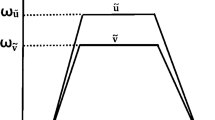Abstract
The problem (or scenario) involving qualitative or imprecise information is not solvable by classical set theory. To overcome the shortcoming of classical set theory, Zadeh (Inf Control 8(3):338–356, 26) introduced the concept of fuzzy sets that generalizes the concept of classical sets. Fuzzy set theory allows modelling and handling of imprecise information in an effective way. As a special class of fuzzy sets, fuzzy numbers (FN) which are very much important in decision making was introduced by Dubois and Prade (Int J Syst Sci 9:631–626, 12). The available methods for solving multi-criteria decision making problems (MCDM) are problem dependent in nature due to the partial ordering on the class of FN. Total ordering on the class of FN by countable number of real-valued parameters was achieved by Wang and Wang (Fuzzy Sets Syst 243:131–141, 21). A complete ranking on the class of trapezoidal fuzzy numbers (TrFNs) using finite number of score functions is achieved in this paper. In this paper, a new ranking procedure (complete) on the class of TrFNs using the concepts of mid-point, radius, left and right fuzziness of TrFN is proposed and further we introduce a method for solving fuzzy multi-criteria decision making (Fuzzy MCDM) problem. Finally, comparisons of our proposed method with familiar existing methods are listed.







Similar content being viewed by others
References
Abbasbandy S, Asady B (2006) Ranking of fuzzy numbers by sign distance. Inf Sci 176(16):2405–2416
Abbasbandy S, Hajjari T (2009) A new approach for ranking of trapezoidal fuzzy numbers. Comput Math Appl 57:413–419
Asady B, Zendehnam A (2007) Ranking fuzzy numbers by distance minimizing. Appl Math Model 31:2589–2598
Baas SM, Kwakernaak H (1977) Rating and ranking of multiple aspect alternative using fuzzy sets. Automatica 13:47–58
Baldwin JF, Guild NC (1978) A model for multi-criterial decision-making using fuzzy logic. In: Proceedings of the workshop of fuzzy reasoning. Queen Mary College, University of London, London
Boender CGE, de Graan JG, Lootsma FA (1989) Multi-criteria decision analysis with fuzzy pairwise comparisons. Fuzzy Sets Syst 29:133–143
Chen SH (1985) Ranking fuzzy numbers with maximizing set and minimizing set. Fuzzy Sets Syst 17(2):113–129
Cheng CH (1994) A new approach for ranking fuzzy numbers by distance method. Fuzzy Sets Syst 95(1998):307–317
Chen SJ, Hwang CL (1992) Fuzzy multiple attribute decision making methods and applications. Lecture notes in economics and mathematical systems. Springer, New York
Chen SM, Sanguansat K (2011) Analyzing fuzzy risk based on a new fuzzy ranking method between generalized fuzzy numbers. Expert Syst Appl 38(3):2163–2171
Deschrijver G (2007) Arithmatic operators in interval valued fuzzy set theory. Inf Sci 177:2906–2924
Dubois D, Prade H (1978) Operations on fuzzy numbers. Int J Syst Sci 9:613–626
Dubois D, Prade H (1983) Ranking fuzzy numbers in the setting of possibility theory. Inf Sci 30:183–224
Ezzati R, Allahviranloo T, Khezerloo S, Khezerloo M (2012) An approach for ranking of fuzzy numbers. Expert Syst Appl 39:690–695
Jain R (1976) Decision making in the presence of fuzzy variables. In: IEEE Transaction on Systems, Man, and Cybernetics, SMC-6. pp 698–703
Jain R (1977) A procedure for multi-aspect decision making using fuzzy sets. Int J Syst Sci 8:1–7
Kerre EE (1982) The use of fuzzy set theory in electrocardiological diagnostics. In: Gupta MM, Sanchez E (eds) Approximate reasoning in decision analysis. North Holland, pp 277–282
Lee ES, Li RL (1988) Comparison of fuzzy numbers based on the probability measure of fuzzy events. Comput Math Appl 15:887–896
McCahone C (1987) Fuzzy set theory applied to production and inventory control. Ph.D. Thesis, Department of Industrial Engineering, Kansas State university
Nakamura K (1986) Preference relation on a set of fuzzy utilities as a basis for decision making. Fuzzy Sets Syst 20(2):147–162
Wang W, Wang Z (2014) Total ordering defined on the set of all fuzzy numbers. Fuzzy Sets Syst 243:131–141
Xu P, Su X, Wu J, Sun X, Zhang Y, Deng Y (2012) A note on ranking generalized fuzzy numbers. Expert Syst Appl 39:6454–6457
Yager RR (1980) On a general class of fuzzy connectives. Fuzzy Sets Syst 4:235–242
Yager RR (1980) On choosing between fuzzy subsets. Kybernetes 9:151–154
Yager RR (1981) A procedure for ordering fuzzy subsets of the unit interval. Inf Sci 24:143–161
Zadeh LA (1965) Fuzzy sets. Inf Control 8(3):338–356
Zimmermann HJ (1987) Fuzzy set, decision making and expert system. Kluwer, Boston
Acknowledgements
Authors are grateful to the anonymous reviewers, Editor and Associate editor for their valuable comments. The corresponding author thanks the Council of Scientific and Industrial Research (CSIR-HRDG), India, for supporting this research under CSIR SRF.
Author information
Authors and Affiliations
Corresponding author
Ethics declarations
Conflict of interest
Authors do not have any conflict of interests.
Ethical approval
This article does not contain any studies with human participants or animals performed by any of the authors.
Rights and permissions
About this article
Cite this article
Ponnialagan, D., Selvaraj, J. & Velu, L.G.N. A complete ranking of trapezoidal fuzzy numbers and its applications to multi-criteria decision making. Neural Comput & Applic 30, 3303–3315 (2018). https://doi.org/10.1007/s00521-017-2898-7
Received:
Accepted:
Published:
Issue Date:
DOI: https://doi.org/10.1007/s00521-017-2898-7



